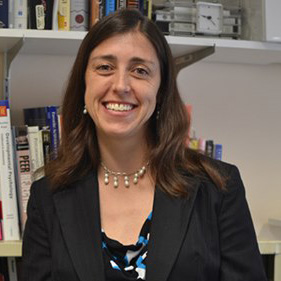In honor of Autism Awareness Month, we’d like to highlight an IES-funded research project on autism spectrum disorder and discuss how the current framework of neurodiversity informs this research. In recent years, the neurodiversity paradigm has been an increasingly popular way of viewing autism and other neurodevelopmental conditions. Neurodiversity is a term coined in the late 1990s by Judy Singer to refer to natural human variation in neurotypes. Neurodivergent individuals diverge from the norm, usually with conditions such as autism, attention-deficit hyperactivity disorder, or dyslexia. Rather than focusing on deficits, this paradigm supports a strength-based view of these conditions while still acknowledging individual challenges. For this blog, we interviewed Dr. Jan Blacher and Dr. Abbey Eisenhower, principal investigators who created a professional development (PD) program supporting general education teachers of students on the autism spectrum. In the interview below, the researchers describe how their PD program works and how it uses the neurodiversity paradigm to strengthen relationships between autistic students and their teachers.
What is Smooth Sailing and what led you to develop it?


Smooth Sailing is the nickname for our PD for general education teachers in kindergarten through second grade who have at least one student on the autism spectrum in their classrooms. The catalyst for the program was the findings from our previous project on student-teacher relationships, indicating that teachers are central to facilitating positive school experiences, especially for autistic students. Warm, positive student-teacher relationships are predictive of academic engagement and social adjustment.
The program provides coaching-based support for teachers, equips them with strategies for building strong relationships with autistic students, and enables them to expand on their students' strengths and interests in the classroom. Developed by educators, clinicians, and researchers in partnership with teachers and autistic individuals, Smooth Sailing uses an autism-affirming, neurodiversity perspective throughout the program.
What makes this program unique?
Smooth Sailing recognizes the importance of relationships—especially student-teacher relationships—in making school a positive and welcoming place for students.
Our program prioritizes a neurodiversity perspective on autism: We recognize autism as a set of differences that are part of the diversity of human experience. In order to best support autistic students, we must provide an affirming context that embraces their strengths and differences. This approach contrasts with a deficit-based model, which focuses on changing children and their behaviors. The deficit model could impair relationships between students and their teachers, making academic engagement and social adjustment worse.
Finally, Smooth Sailing is unique for centering on autistic people as key contributors to shaping program content so that the program reflects the lived realities of autistic students.
What have you learned while developing and testing the Smooth Sailing intervention?
We have learned several important lessons:
(1) During the initial research for our intervention, findings indicated that only 8% of general education teachers in the study had received any professional training in autism. This provides a clear-cut mandate for more autism-focused training for these educators.
(2) After the intervention, general education teachers endorsed three key Smooth Sailing strategies for reaching out to their autistic students: (a) identifying interests, (b) celebrating talents, and (c) having one-on-one time to form stronger relationships. We learned that these simple strategies are ones every teacher can adopt to create more inclusive classrooms and cultivate stronger relationships with students, especially autistic students.
(3) Overall, teachers who received the Smooth Sailing PD experienced significant improvements in the quality of their relationships with autistic students, including higher student-teacher closeness and lower student-teacher conflict, compared to teachers who had not received the program. Thus, in addition to other positive outcomes for teachers and children, we learned that our brief program (12 hours over 4 weeks) was sufficient for moving the needle on the critical construct of student-teacher relationship quality.
How does respect for neurodiversity inform the Smooth Sailing intervention and your philosophies as researchers?
One key factor that has been transformative to the resulting Smooth Sailing program has been our close consultation with current and former autistic students. As part of developing the Smooth Sailing program for teachers, our research team interviewed many autistic adolescents and adults about their school experiences, their advice for teachers, and their opinions on making schools more affirming and inclusive. In addition, we closely engaged autistic adults as expert consultants during our program development process. These consultants advised on teacher-focused content, reviewed materials, and weighed in on program changes.
The rich information we learned from the interviews and intensive consultation substantially impacted the content of the resulting program. To offer one example, these interviews showed us the outsized power of a positive student-teacher relationship, even with just one teacher, in making school a bearable place for autistic students.
Because many autistic students describe their school experiences as ableist and marginalizing, our team's programming aims to disrupt these school problems by building strong student-teacher relationships and fostering teachers' understanding of autism through an affirming, neurodiversity-informed lens. By incorporating first-person perspectives of autistic students and adults in its creation and content, our programs affirm the lived realities of autistic students.
What needs are still unmet for general education teachers working with autistic students?
We have heard from teachers and administrators at all K-12 levels—high school, middle school, and later elementary school—that they would like access to similar autism-focused PD programs targeted to the student age ranges they teach. We think that creating a school culture that affirms neurodiversity starts by fostering understanding between students and all school staff, not just primary classroom teachers.
What's next for the Smooth Sailing project?
We hope to expand the Smooth Sailing PD program to the early childhood education context. Unfortunately, our research has shown that, by the time they enter elementary school, one out of every six autistic children has been expelled from a preschool or childcare program. Viewed through a social justice lens, this preschool expulsion is an educational equity issue.
Early childhood educators are key to improving these early school experiences. We believe that preschool and childcare educators can be catalysts in providing an inclusive environment by forming strong relationships with autistic and neurodivergent children. That said, most early childhood educators report having no professional training in autism, feeling underprepared to meet the needs of autistic children, and wanting more support for inclusion. We hope that programs like Smooth Sailing can be applied to support educators working with preschool-age children who are autistic or neurodivergent, many of whom are not yet diagnosed, so that their first school experiences can be enriching and inclusive.
Jan Blacher is a distinguished research professor in the School of Education and the director of the SEARCH Family Autism Research Center at the University of California, Riverside. Abbey Eisenhower is an associate professor in the Psychology Department at the University of Massachusetts, Boston.
This blog was authored by Juliette Gudknecht, an intern at IES, along with Emily Weaver (Emily.Weaver@ed.gov), program officer at NCSER with oversight of the portfolio of autism grants.